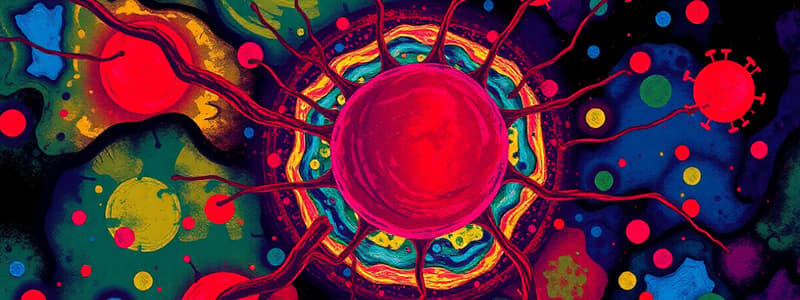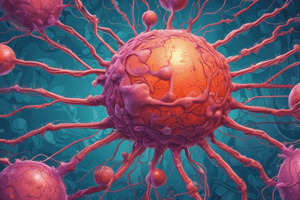Podcast
Questions and Answers
What is a key characteristic of apoptosis as it relates to the cell nucleus?
What is a key characteristic of apoptosis as it relates to the cell nucleus?
- The nucleus expands and divides
- The nucleus merges with the cytoplasm
- The nucleus remains unchanged
- The nucleus condenses and fragments (correct)
Which of the following correctly describes caspases?
Which of the following correctly describes caspases?
- Effectors of cell division
- Enzymes activated by other proteins during apoptosis (correct)
- Proteins involved in immune response
- Inactive compounds that promote cell survival
What happens to the cytoplasm during the process of apoptosis?
What happens to the cytoplasm during the process of apoptosis?
- It condenses and fragments into apoptotic bodies (correct)
- It swells and merges with other cells
- It remains stable and unchanged
- It becomes proliferative and grows
Which apoptotic pathway is triggered by external signals?
Which apoptotic pathway is triggered by external signals?
Which of the following is a biochemical change that occurs during apoptosis?
Which of the following is a biochemical change that occurs during apoptosis?
Which type of cell death is characterized by an immune response and can be induced by various stimuli?
Which type of cell death is characterized by an immune response and can be induced by various stimuli?
What cellular process involves programmed cell death that is crucial for maintaining tissue homeostasis?
What cellular process involves programmed cell death that is crucial for maintaining tissue homeostasis?
What is the relationship between mutations in genes and the development of cancer?
What is the relationship between mutations in genes and the development of cancer?
Which of the following statements accurately describes oncogenes?
Which of the following statements accurately describes oncogenes?
Which process is not typically associated with programmed cell death?
Which process is not typically associated with programmed cell death?
What is a key morphological characteristic of apoptosis compared to necrosis?
What is a key morphological characteristic of apoptosis compared to necrosis?
Which statement is true regarding the cellular membrane integrity in apoptosis and necrosis?
Which statement is true regarding the cellular membrane integrity in apoptosis and necrosis?
What drives the process of apoptosis regarding cellular signals?
What drives the process of apoptosis regarding cellular signals?
Which of the following events is NOT associated with necrosis?
Which of the following events is NOT associated with necrosis?
In apoptosis, how is DNA typically fragmented?
In apoptosis, how is DNA typically fragmented?
What happens to the cell during necrosis in terms of ATP?
What happens to the cell during necrosis in terms of ATP?
Which of the following statements best describes the tissue impact of apoptosis compared to necrosis?
Which of the following statements best describes the tissue impact of apoptosis compared to necrosis?
Which signal is likely to promote cell survival rather than apoptosis?
Which signal is likely to promote cell survival rather than apoptosis?
What is the primary role of caspases in cellular processes?
What is the primary role of caspases in cellular processes?
What is required for caspase activation?
What is required for caspase activation?
What is the primary function of tumor suppressor genes?
What is the primary function of tumor suppressor genes?
Which pathway is categorized as extrinsic in apoptosis?
Which pathway is categorized as extrinsic in apoptosis?
What happens when there is a disruption or deletion of the p53 gene?
What happens when there is a disruption or deletion of the p53 gene?
Which ligand is matched correctly with its receptor?
Which ligand is matched correctly with its receptor?
Which of the following genes is associated with retinoblastoma?
Which of the following genes is associated with retinoblastoma?
What is the role of p21 in relation to p53?
What is the role of p21 in relation to p53?
What effect does ligand-induced trimerization have on death receptors?
What effect does ligand-induced trimerization have on death receptors?
Which of the following is NOT a consequence of mutated oncogenes?
Which of the following is NOT a consequence of mutated oncogenes?
What is Apaf1's role in the intrinsic apoptotic pathway?
What is Apaf1's role in the intrinsic apoptotic pathway?
What is a common disorder associated with the DCC gene?
What is a common disorder associated with the DCC gene?
Which method is suitable for detecting apoptotic changes in DNA?
Which method is suitable for detecting apoptotic changes in DNA?
Which molecule is a death effector in the apoptosis signaling pathway?
Which molecule is a death effector in the apoptosis signaling pathway?
Which one of the following genes is implicated in lung cancer on a sporadic basis?
Which one of the following genes is implicated in lung cancer on a sporadic basis?
Which factor is involved in regulating programmed cell death?
Which factor is involved in regulating programmed cell death?
What role does apoptosis play in adult physiology?
What role does apoptosis play in adult physiology?
What distinguishes necroptosis from traditional necrotic cell death?
What distinguishes necroptosis from traditional necrotic cell death?
In what context does autophagy mainly exert cytoprotective functions?
In what context does autophagy mainly exert cytoprotective functions?
What is a consequence of inhibiting autophagy during developmental processes?
What is a consequence of inhibiting autophagy during developmental processes?
Which of the following diseases is associated with excess apoptosis?
Which of the following diseases is associated with excess apoptosis?
What is the main characteristic of autophagic cell death?
What is the main characteristic of autophagic cell death?
What is a primary outcome of necroptosis in cells?
What is a primary outcome of necroptosis in cells?
What happens when TNFalpha-mediated necrosis is inhibited?
What happens when TNFalpha-mediated necrosis is inhibited?
Flashcards
Apoptosis
Apoptosis
A form of programmed cell death characterized by cellular shrinkage, intact membranes, ATP dependence, and phagocytosis without tissue inflammation.
Necrosis
Necrosis
A form of cell death characterized by cellular swelling, membrane breakdown, ATP depletion, cell lysis, and inflammation.
Phagocytosis
Phagocytosis
The process of engulfing and degrading cellular debris by specialized immune cells.
DNA Fragmentation in Apoptosis vs Necrosis
DNA Fragmentation in Apoptosis vs Necrosis
Signup and view all the flashcards
Positive Signals
Positive Signals
Signup and view all the flashcards
Negative Signals
Negative Signals
Signup and view all the flashcards
Decision to Activate Apoptosis
Decision to Activate Apoptosis
Signup and view all the flashcards
Apoptosis Execution
Apoptosis Execution
Signup and view all the flashcards
Intrinsic Apoptosis
Intrinsic Apoptosis
Signup and view all the flashcards
Extrinsic Apoptosis
Extrinsic Apoptosis
Signup and view all the flashcards
Caspases
Caspases
Signup and view all the flashcards
Nucleosome Ladder
Nucleosome Ladder
Signup and view all the flashcards
Extrinsic Apoptosis Pathway
Extrinsic Apoptosis Pathway
Signup and view all the flashcards
Intrinsic Apoptosis Pathway
Intrinsic Apoptosis Pathway
Signup and view all the flashcards
Death Receptors
Death Receptors
Signup and view all the flashcards
Death Effectors
Death Effectors
Signup and view all the flashcards
IAPs
IAPs
Signup and view all the flashcards
Assesing Apoptosis
Assesing Apoptosis
Signup and view all the flashcards
What is apoptosis?
What is apoptosis?
Signup and view all the flashcards
What is necrosis?
What is necrosis?
Signup and view all the flashcards
How is apoptosis linked to cancer?
How is apoptosis linked to cancer?
Signup and view all the flashcards
What are oncogenes?
What are oncogenes?
Signup and view all the flashcards
What are Tumor suppressor genes?
What are Tumor suppressor genes?
Signup and view all the flashcards
Proto-oncogene
Proto-oncogene
Signup and view all the flashcards
Oncogene
Oncogene
Signup and view all the flashcards
Tumor suppressor gene
Tumor suppressor gene
Signup and view all the flashcards
Programmed Cell Death
Programmed Cell Death
Signup and view all the flashcards
Growth Factors
Growth Factors
Signup and view all the flashcards
Survival Factors
Survival Factors
Signup and view all the flashcards
How does autophagy work?
How does autophagy work?
Signup and view all the flashcards
What is necroptosis?
What is necroptosis?
Signup and view all the flashcards
How is apoptosis important in the immune system?
How is apoptosis important in the immune system?
Signup and view all the flashcards
Why is apoptosis essential for development?
Why is apoptosis essential for development?
Signup and view all the flashcards
What happens when there's too much or too little apoptosis?
What happens when there's too much or too little apoptosis?
Signup and view all the flashcards
What is the Comet assay?
What is the Comet assay?
Signup and view all the flashcards
What are the applications of the Comet assay?
What are the applications of the Comet assay?
Signup and view all the flashcards
Study Notes
Cell Death & Apoptosis
- Cell death is a crucial process for maintaining a constant number of cells in the body.
- Two major forms of cell death are apoptosis (programmed cell death) and necrosis (cell death, via injury).
- Apoptosis is a controlled, tightly regulated process that removes cells without damaging surrounding tissues.
- Necrosis is an uncontrolled process triggered by cell injury/damage and leads to inflammation.
- Apoptosis is a very common process during embryo development.
- Embryo development involves programmed cell death to mold and refine the shape.
- The tail of the tadpole is absorbed via apoptosis.
- In adult multicellular organisms, billions of cells are lost via apoptosis each hour. Most of these cells do not have defects and are removed based on the controls of regulation and development.
Apoptosis Objectives
- Understand the various types of cell death pathways.
- Assess methods to assess cell death.
- Understand the physiological processes of apoptosis.
- Analyze how defects in apoptotic pathways relate to diseases.
Types of Cell Death
- Apoptosis = programmed cell death (suicide)
- Necrosis = cell killing/decay/destruction
Morphological Apoptosis Changes
- Changes in cell morphology during apoptosis:
- Cell shrinkage
- Chromatin condensation
- Nuclear fragmentation
- Formation of apoptotic bodies
- Phagocytosis of apoptotic bodies
Biochemical Changes in Apoptosis
- Caspase activation (enzymatic proteases).
- Endonuclease activation.
Caspases
- Enzymatic proteins (proteases) that degrade other proteins.
- Made as inactive precursors (procaspases).
- Activation occurs upon receiving specific signals.
- A single caspase can cleave lamin proteins, causing breakdown of the nuclear membrane.
Caspase Functions and Structure
- Proteolytic cleavage activates caspases.
- Prodomain and linker region are removed.
- Large and small subunits form an active enzyme complex.
- Two heterodimers interact to form a tetramer with catalytic sites.
- Caspase family contains over 14 members.
Apoptotic Pathways
- Extrinsic (death receptor) pathway
- Signals via death receptors.
- These receptors induce activation of caspase-8, leading to apoptosis.
- Intrinsic (mitochondrial) pathway
- Signals from inside the cell.
- Release of cytochrome c from mitochondria triggers caspase-9 activation and apoptosis.
Ligand/Death-Induced Cell Death
- Ligands and receptors involved in cell death. Examples provided in chart format for Ligands, FasL, TNF,TRAIL and Receptors, Fas (CD95), TNF-R, DR4 (Trail-R).
Cancer & Apoptosis
- Evasion of apoptosis can lead to uncontrolled cell growth.
- Activating apoptosis in cancer cells has potential as a treatment method.
- Cancer is a genetic disease.
- Occurring via mutations in genes. This results in altered proteins during cell division.
- Cancer originates from mutations in somatic or germline cells.
Genes Playing a Role in Cancer Development
- Oncogenes
- Tumor suppressor genes
- DNA repair genes
Functions of Proto-Oncogenes
- Secreted growth factors.
- Growth factor receptors
- Cytoplasmic signal transduction proteins
- Nuclear proteins; regulating transcription
- Cell growth genes
Oncogenes
- Mutated proto-oncogenes.
- Always activated.
- Constantly stimulate proliferation.
- Example: mutated ras gene, always active
Tumor Suppressor Genes
- Normal function is inhibiting cell proliferation to guard against uncontrolled cell growth.
- Absence/inactivation leads to increased cancer risks (leading to uncontrolled cell growth).
- Example: p53, BRCA1, BRCA2
p53 Tumor Suppressor Gene
- Activated by DNA damage.
- Triggers cell cycle arrest or apoptosis.
- Inactivation is associated with cancer.
- p53 phosphorylated; activates p21 gene causing arrest of cell cycle to allow time for DNA repair.
Cancer Treatment Therapies
- Various methods for cancer treatment. Diagram displays the major pathways.
Promising Cancer Targets
- HERCEPTIN
- STI-571
Apoptosis: Programmed Cell Death
- (True/False) In adult tissues, cell death balances cell division.
- Apoptosis involves controlled self-destruction to prevent damage to neighboring cells.
- Signals from within and external sources trigger apoptosis.
- Cellular components like caspases and mitochondria are key players in the apoptotic process.
- Distinction between mitogens, growth factors and survival factors.
- Apoptosis occurs during a specific portion of the cell cycle.
- Telomeres and telomerase impact cell aging/death.
- Specific cell types in the body are designed to divide, grow, or both.
Autophagic Cell Death
- Autophagy is a self-eating process that takes place in both healthy and diseased cells.
- Autophagy can play a protective or destructive role during stress reactions.
Necroptosis
- Necroptosis is a form of necrotic cell death, considered programmed or regulated.
- Discovery of the RIP1 kinase inhibitor as necroptosis-inhibiting; lead to recognition of necroptosis in cell death pathways.
- Necroptosis is a programmed necrotic cellular death pathway.
Other Cell Death Classifications
- Other kinds of cell death pathways exist (such as ferroptosis, lysozomal cell death, mitotic cell death, pyroptosis, etc.)
Studying That Suits You
Use AI to generate personalized quizzes and flashcards to suit your learning preferences.
Related Documents
Description
This quiz explores the key characteristics of apoptosis, including its relationship with the cell nucleus and the role of caspases. Additionally, it delves into how apoptosis is linked to cancer development and the distinctions between various types of cell death. Test your knowledge on these crucial aspects of cell biology!





